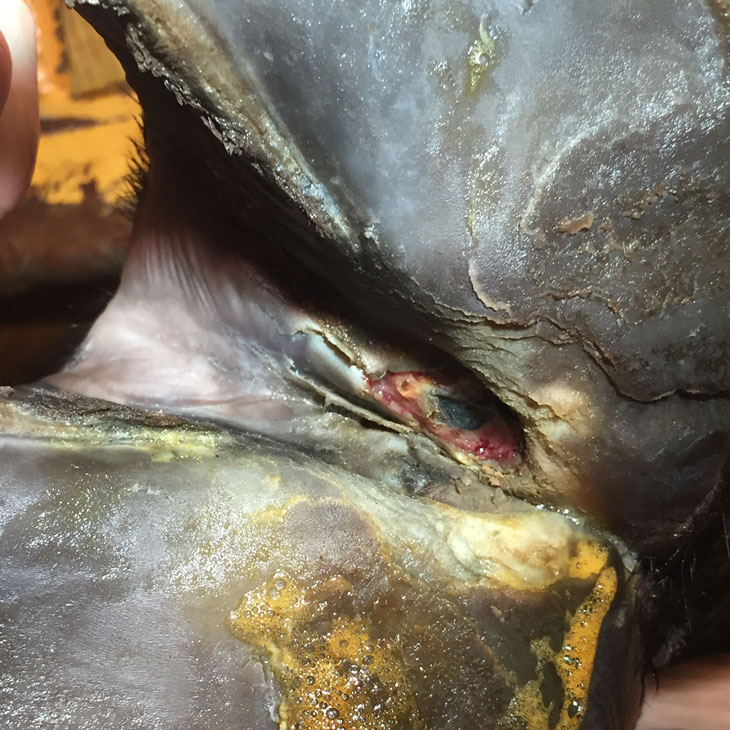
What if it’s foot rot? What if it’s not?
Monday, December 10, 2018
Increased rain can cause lameness in cattle. The most common cause of lameness in beef cattle after rains is foot rot, an infection of the skin between the toes of cattle that extends into underlying tissues and can cause swelling, severe lameness, and dying tissue between the toes. The key to successful treatment is proper identification of the condition and timely treatment with appropriate medications.
It is important to recognize the symptoms of foot rot and to differentiate it from more severe joint infections:
Step 1: View the affected foot from the front. Cattle with foot rot will have roughly equal swelling of both toes that frequently extends up to the fetlock, with the swelling often great enough to cause separation of the toes.
If, however, one toe or side of the foot is more swollen than the other, this indicates a joint infection, which is more serious and will not respond to the treatments discussed below. A veterinarian should be consulted for these cases.
Step 2: If it can be done safely in your facilities, pick up the affected foot with a rope and look between the toes. When examining in between the toes of a cow, never run your finger through the space to clean it, use another tool. It is possible for sharp objects to be in that area causing the lameness and may result in a severe cut on your finger.
Normally, once the mud and manure are cleared, the skin should be nice and smooth.
Figure 1 is the foot of a beef cow with a very typical foot rot lesion. The space between the toes has been cleaned to reveal a grooved area of dead tissue with irritated pink tissue surrounding it. This area has a very foul odor and is very painful.
Step 3: If you see symmetrical foot swelling and find dead tissue with a foul odor between the toes, it is appropriate to presume foot rot is the cause of lameness and treat as discussed below.
Foot rot is a multifactorial problem usually secondary to an abrasion or damage to the skin between the toes. Animals at high risk include those living in moist, muddy lots, those on wet pasture, or those in areas where sharp gravel, concrete or stubble exist.
Fusobacterium necrophorum is the bacteria that invades this tissue and causes the foul odor and infection along with other bacteria. These bacteria are present in all environments. However, when introduced into the damaged skin and then covered in mud for instance, they proliferate well.
Foot rot can be costly if it is not treated appropriately. The good news is that if diagnosed and treated properly, the recovery is relatively uneventful and improvements can be seen within a few days.
Injectable antibiotics are the most appropriate choice for this condition, with both over-the-counter and prescription options available. Several antibiotics are labeled for the treatment of foot rot, such as oxytetracycline, including Bio-Mycin® 200 or Liquamycin LA-200®, florfenicol, (Nuflor®) ceftiofur (Excede® or Excenel®) and tulathromycin (Draxxin®). Oxytetracycline is available over the counter, the others are available by prescription through your veterinarian.
It is important to use these products exactly as directed on the label and with attention to Beef Quality Assurance guidelines.
In some situations, your veterinarian may suggest more aggressive treatments, including cleaning and careful removal of dead tissue, which can be painful and may require a local anesthetic. After this treatment the lesion can be treated with a topical antimicrobial ointment and bandaged, which will require housing in a dry area for the duration of the bandaging.
The good news is that, with timely and appropriate treatment, most animals will transition from severe lameness to soundness within a few days of treatment of foot rot. If this does not occur, it is important that your veterinarian be contacted to evaluate the animal.
More severe causes of lameness, such as joint infections or sole abscesses, can be mistaken for foot rot and require a different course of treatment. Foot rot can also progress into deeper tissues, causing more severe infections. For these reasons, a correct diagnosis and timely treatment are critical to maintaining an animal’s soundness.
Although early and uncomplicated foot rot generally responds well to treatment, production losses and animal welfare concerns make prevention of this condition an important goal. Keeping cattle in a well-drained environment may not always be possible, but should occur whenever possible. Trace mineral supplementation should be a part of every nutritional program. The inclusion of iodine, copper, selenium, zinc, and biotin have been shown to support overall foot and hoof health.
There are commercially available vaccines against the primary bacteria which causes foot rot. While they can be useful as part of a control program, they cannot be expected to overcome an environment conducive to foot infection.
Keeping cattle comfortable is key to maintaining productivity. Being mindful of pasture conditions that may cause foot problems, providing solid nutrition, monitoring cattle more closely during times of increased risk, and identifying and treating any animal with lameness in a timely fashion are important steps in protecting your herd’s very foundation.
STORY BY: Meredyth Jones, DVM, MS, DACVIM (LA)
MEDIA CONTACT: Taylor Bacon | Public Relations and Marketing Coordinator | 405-744-6728 | taylor.bacon@okstate.edu
